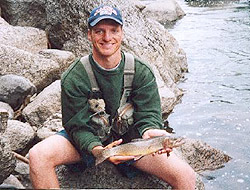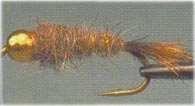
With their uninhibited willingness to quickly gobble down flies, the brilliant coloration and tell tale cutthroat marks adorning the underside of its jaws; the cutthroat trout has to be one of the most sought after of all the trout species by fly anglers. The most famous of the cutthroat trout species is the Westslope cutthroat trout which was discovered in 1805 by Lewis and Clark below the great falls of the Missouri River. A few years after the original discovery the word had spread throughout the fly fishing community about these fish's spirited fighting ability and distinct coloration and the interest from fisherman never faded.
 |
| One of the main color characteristics that people associate the cutthroat with is two yellow/orange or red lines in the skin folds of the underside of the lower jaw. |
With their uninhibited willingness to quickly gobble down flies, the brilliant coloration and tell tale cutthroat marks adorning the underside of its jaws; the cutthroat trout has to be one of the most sought after of all the trout species by fly anglers. The most famous of the cutthroat trout species is the Westslope cutthroat trout which was discovered in 1805 by Lewis and Clark below the great falls of the Missouri River. A few years after the original discovery the word had spread throughout the fly fishing community about these fish's spirited fighting ability and distinct coloration and the interest from fisherman never faded.
About the Cutthroat
Cutthroat can be characterized as having short, conical heads with a somewhat pointed to rounded snout and a rather large mouth holding sharp developed teeth on both the upper and lower jaws. One of the main color characteristics that people associate the cutthroat with is two yellow/orange or red lines in the skin folds of the underside of the lower jaw. As far as the body color for these inland cutthroats is concerned it really depends on when and where you catch these fish. The colors can range from olive, yellow, to silver with orange to red highlights depending on what time of year it is. The coastal form of the cutthroat is colored differently than its inland brethren, with dark to olive-green coloration with numerous black spots.
Cutthroat, like all the other trout species, are an indicator species meaning they normally can only live in the cleanest, coldest waters. These rivers or lakes can be made up of fresh, brackish or salt water but some of the highest densities of inland species of these fish can be found in North America slightly west of the Rocky Mountains.
Lifecycle
With the adult anadromous forms of cutthroat the return migration to their freshwater spawning streams begins in late autumn and early winter, but the actually spawning for both types of fish takes place somewhere between February and May. Spawning cutthroat will run high up their native rivers finding a quiet, gravelly, slow tail out location to begin the courtship. Once the males and females have paired the female prepares the redd, and deposits anywhere from 1,100-1,700 eggs. After the eggs have been fertilized, the tiny fry will develop and eventually hatch 6-7 weeks later. Water temperatures for this spawning process are generally around the 10 degree Celsius mark. The fry will usually emerge in July, which coincides with the peak productivity of the watershed they live in, giving them the best chance to feed and grow quickly. The average length of this species ranges from 12 to 15 inches and is generally one-half to 2 pounds. Sexual maturity occurs at an age between 2 and 4 years then the process repeats itself.
Fishing Techniques
The cutthroat trout has become regarded as one of the best species to target with a fly rod. Nestled away in astonishing landscapes and in some of the most spectacular rivers in North America the cutthroat trout entices all who love to fly fish. The real beauty of cutthroat trout is that they are a working-man's fish. Whereas browns and brookies tend to disappear in blue bird days with high sun, cutthroat trout are never too weary to come out and play. Additionally, if you are fishing for cutthroats, than there is no real need for those extra-early sunrise starts, which is very convenient for those of you working full time jobs. Nymph flies are a good place for anglers to start if they are fishing a new body of water, or fishing ahead of oncoming storms.
Cutthroat for some reason or other seem to key in on these subsurface presentations and strike nymphs greedily with the coming of inclement weather. Most often cutthroat are fished for and caught with dry fly patterns emulating stoneflies, caddis flies and mayflies. Anglers should look for typical holding cover as cutthroats are ambush predators. Good cover for cutthroat comes in the form of as eddies, log jams, large boulders, transitions between fast and slow water and oxygenated riffles. Over the last few years in heavily fished areas such as the Yellowstone National Park, cutthroat on certain days appear to become quite finicky, and tough to fool. Whether it is the years of catch & release, or just general malaise the large cutthroat will turn up their noses to everything you have to offer. Fortunately for anglers just as quick as this stubborn behavior had set in, it will depart and these large cutthroats for no reason will be attacking flies faster then you can cast them in the water.
Fly Selection
Cutthroat trout will eat just about anything that fly anglers can cast out onto a river quietly, making the group of effective flies used for these fish very large. Cutthroat like other trout will regularly consume a wide variety of aquatic insects and invertebrates but dabble a little with any unfortunate land insects like ants, beetles, and hoppers that happen to get blown into the water. With such a widely-ranging diet, choosing the right fly to use might seem tough but it really is not. Cutthroat trout are not discriminating feeders, if you do not match the hatch exactly, fish will still take interest in your flies. A good idea is to carry a few of the well known general imitator type patterns for nymphs and dries such as the hares ears and princes, to Hendrickson's and March Browns. Attractor patterns can also do a good job in catching fish especially when there is no sign of a hatch going to bloom that night. Streamer patterns have also shown good results with cutthroats. Generally these fish fall victim to wooly buggers, and leech type patterns tied with breathable materials. Basically, when fly fishing for cutthroat you want to try and match the hatch as best you can, but more importantly just get a fly out in front of these fish's faces and see if you are generating any interest.
 |
| Good Selection. A good idea is to carry a few of the well-known general imitator type patterns for nymphs and dries such as the hares ears. |
In you are going to be fishing cutthroats in the early spring, the resident aquatic insects will just start to get going at this time making using nymphs a very effective technique. Stoneflies and Caddis's are usually some of the best early action for fly anglers with Mayflies heating up soon after. A good point to remember is that with the spring months come dark colored insects so any nymph pattern using dark browns or black should suffice. As summer heats up the insects will become lighter in color and smaller in size so tailoring your efforts towards these types of bugs should produce handily. Your best bet when this heat of summer comes into play is to use dry fly patterns as much as you can. Cutthroats have a weakness for dead-drifted flies, and it can make for a great day out on the water watching fish rise readily after you're dry. Fishing dries can be especially effective if you are going to be fishing a pastureland stream. Winds over these grassy areas will frequently blow terrestrial insects into the water where the opportunistic cutthroat will rarely pass up an easy meal.
Later during the year cutthroats will continue to feed on nymph and dries if the weather is good but turn to feeding on small resident minnow imitations and egg patterns. Once the larger fish reach the redds and the spawn begins, eggs flies drifted slowly downstream in bright oranges and pinks will catch some good fish. At this time of the year most cutthroat steams will be closed so make sure that you check the local regulations to see where and how you are able to fish.
Weather & Sunlight
As was alluded to earlier, sunlight really does not play a very important role in the feeding habits of cutthroat trout. Whether it be sunny or overcast cutthroat will do as they always do, look to feed aggressively. Heavy rain can slow things up a bit by muddying the waters and making it hard to come into contact with fish. As the level of the river water rises due to rain the clarity will decreases making any fishing efforts unfruitful. Wait a few days until the level of the water starts to recede and the fish will once again become active. If you do decide to fish while the water is still a bit discolored, the key to consistently catching fish is to fish the water slow. Fish in these types of conditions will have a hard time seeing and accurately striking flies so giving them as much of a chance to get a good, long look at what you are offering works only to your advantage.
Cutthroat streams are visited by thousands of fly anglers from far and wide every year for a few main reasons; these fish are extravagantly colored, tough fighters and greedily feed on flies presented by even novice anglers. Getting the chance to fish these great trout does not have to be a trip of a lifetime, they are wide-spread through North America and one needs to just take the time a see what the rivers around them have to offer. Get out and let a few dries ride the water, it won't take long to get a few cutthroat interested in what you have to offer.
- 30327 views

